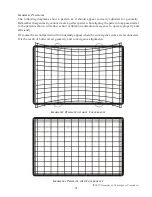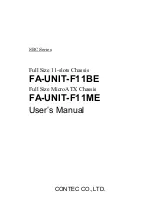
ITC222 Geometry & Convergence Procedures
6
I
NTRODUCTION
Geometry and convergence for the ITC222 are more interactive than previous chassis designs. If
geometry is not correct or too far from nominal settings, even though geometry and convergence
both look acceptable, autoconvergence may not operate. While it may be tempting for the technician
to return the set to the consumer with both agreeing autoconvergence will not work, it is not a
recommended or endorsed completion to a repair.
The purpose of this manual is to show the interaction of geometry and convergence and how it
affects screen geometry, sensor location (sensor calibration) and autoconvergence. Autoconvergence
and manual convergence must be considered separate processes to be understood. Convergence is
digital and follows a similar process done in previous years. A technician must manually converge
the instrument using digital convergence. Autoconvergence is the process of determining where
manufacturing (or the technician) manually aligned convergence for acceptable performance, then
automatically return it to that alignment appearance when necessary.
It also must be understood that Geometry is controlled globally via the main deflection yokes
using individual adjustments in the Geometry menu. Geometry controls all three colors at the
same time in the same way. Convergence is independent of geometry being controlled and adjusted
by individual convergence yokes on each of the three CRT’s. But if Geometry is misadjusted
convergence may not have enough power to overcome it and proper convergence would be in
jeopardy.
There are two steps to the Autoconvergence routine; Sensor Calibration and Autoconvergence.
When the “Sensor Location” routine is run, convergence is set to a “neutral” state and the sensor
location blocks are influenced more by geometry. So if geometry is too far off, sensor location
(calibration) will fail. If sensor calibration fails, autoconvergence will also fail.
It is also possible for geometry to be misadjusted just far enough to allow sensor location to complete
yet proper convergence of all three CRT’s may not be possible because the convergence amplifiers
are railed trying to overcome the geometry yokes in order to correct the alignment points. The
correct geometry alignment is one that puts geometry in more of a nominal state allowing
convergence the greatest range.
This manual is arranged so the Geometry and Convergence procedures appear in order. However
that is not necessarily how they should be done, nor does every detail of each procedure have to be
done. Which procedures and details are required for each repair depend more on the situation.
The answer to the following questions have considerable influence over which procedures must be
used and how critical each is.
1.) Is convergence being done as the result of one or more CRT replacements?
2.) Is convergence needed after replacement of an SSB module?
3.) Is convergence required as the result of a consumer complaint?
a.) Misconvergence, or
b.) Autoconvergence routine not functioning
The remainder of the manual is based on answers to these questions.







































